NanoInFocus Image Contest Finalists
The NanoInFocus image contest finalists below are listed in alphabetical order by the artist’s last name.
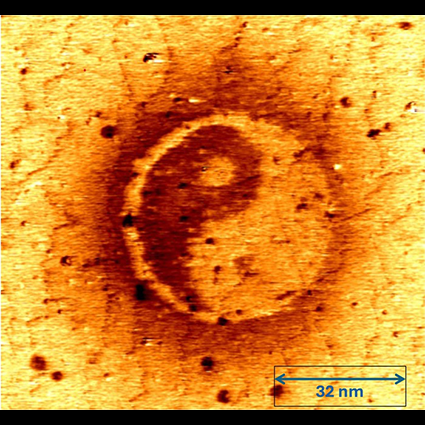
Yin-Yang
Artist: Joshua Ballard
Description: This image may appear to be a celestial yin-yang with a visible corona, but it is actually a silicon surface mostly covered with hydrogen except for the bright parts of the symbol. The symbol was printed using atomic precision lithography (APL) with a scanning tunneling microscope (STM) and was imaged by the same STM using an ultrafast spectroscopy mode that is sensitive to surface-charging effects. Two aspects of this image should be noted. First, the lithography method used a constant speed raster path, an entirely new approach to APL that is compatible with massively parallel multi-tip arrays. A second interesting feature is that the ultrafast spectroscopy shows significant surface charging near where patterning has been performed. Surprisingly, the “corona” is most prominent near where less hydrogen has been removed. This image represents advances in fabrication and analysis that inform many fields from fundamental chemistry to quantum information processing.
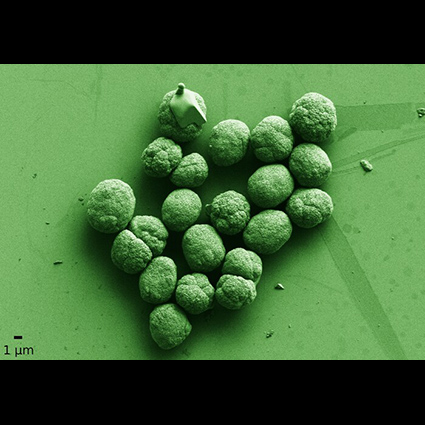
Micro-Broccoli (Second-place winner)
Artist: Caleb DeWitt
Description: This image displays a Scanning Electron Micrograph of calcium carbonate crystals of the vaterite polymorph. The fluffy appearance of the crystals resembles the florets of a broccoli head. Much like broccoli’s recent cancer-fighting discoveries, calcium carbonate has proved itself as more than a household commodity such as antacids or chalk. Calcium carbonate crystals are being researched at the nanoscale for usage as delivery agents for ocular drugs. Many ocular drugs have a difficult time passing through ocular tissue due to lacrimal drainage and blinking, but calcium carbonate nanoparticles would be sturdy enough to resist clearance from the eye and also small enough to enter. These broccoli-appearing crystals could be the next step for ocular drug delivery!
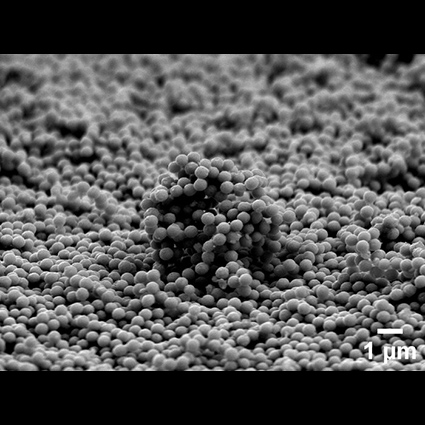
Landscape of Nanospheres (Third-place winner)
Artist: Matthew Hershey
Description: With the growing climate crisis, new technologies that rely on renewable energy sources are needed. Common materials, such as titanium dioxide, are extremely common in our daily lives. However, when titanium dioxide is scaled down to ~300-500 nanometers spheres, a wide range of the visible light from the sun can be utilized to drive chemical reactions that are important for a more sustainable world. However, these properties are not found in larger, bulk titanium dioxide, which makes imaging of these nanoparticles extremely important. In order to have an effective material to use light, the size and shape of the titanium dioxide needs to be uniform. Scanning electron microscopy (SEM) imaging, which is shown here, can allow us to see these extremely small particles with high resolution.

Momentary Order: Light-Harvested Nanofibers in Transition
Artist: Tyler Jaynes
Description: This image showcases transient nanofibers formed through light harvesting. Upon absorbing visible light, the constituent molecules self-assemble into nanofibril structures that temporarily store energy for driving chemical reactions. However, these ordered structures are short-lived; exposure to air initiates their gradual disintegration. This transmission electron micrograph captures the delicate balance between the formation and decay of these nanostructures, illustrating their brief, yet dynamic, existence.
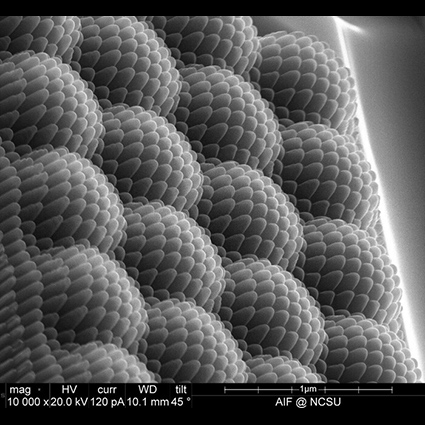
Hierarchical Diamond Die
Artist: Lauren Micklow
Description: A diamond has been patterned with a focused ion beam to create a dual scale texture. Following this small-scale patterning process, the diamond will then be used as a stamp to replicate the pattern millions of times. This particular pattern is used on top of solar cells to trap light and make them more efficient.

The Butterfly’s Wingtip
Artist: Natalie Nicolas
Description: This image shows the ridges on the edge of a butterfly’s wing scale. It was taken as part of a project to characterize structures in butterfly wings that can perform radiative cooling, where the scale reflects wavelengths in the infrared in order to reduce heat. This research both helps us better understand the evolutionary biology of butterflies and enables us to try to reconstruct those structures in man-made materials for paints and fabrics that can cool without energy input.
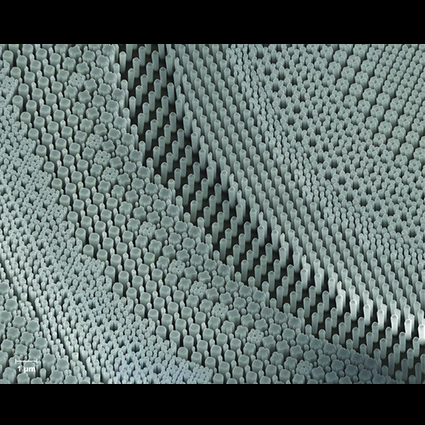
Light’s Labyrinth: The Nano-Sculpture Garden
Artist: Md Tarek Rahman
Description: This monochromatic landscape, a microscopic garden of nanopillars, is a triumph of scientific ingenuity—a metalens at the forefront of technology. Like a meticulously sculpted garden, each pillar stands with precision and artistry, their uniformity a testament to the elegance of advanced nanofabrication techniques. At this scale, the pillars rise like stalagmites from the unseen depths of a silicon cave, their contours playing with shadows and light. Though cast in shades of gray, these minute sentinels are capable of bending light across the colors of the rainbow and focusing them on a single focal spot. This image is a convergence of art and science, revealing the engineered structures of the nano-world as both a functional marvel and an abstract masterpiece.
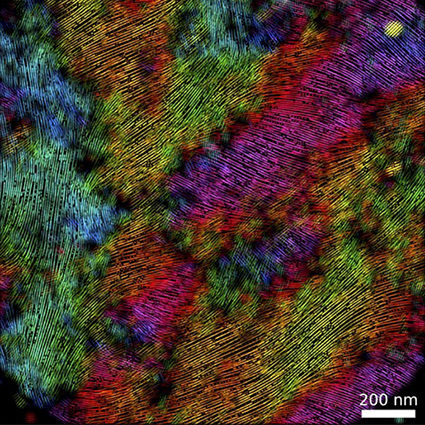
Orientation Map of a Conductive Film in Application Condition
Artist: Yael Tsarfati
Description: This orientation map shows the alignment of polymer chains in an organic film that conducts both electrons and ions. The film was frozen in a dynamic state during immersion in 0.1M NaCl(aq), with moderate doping induced by applying a voltage. The map, created using cryogenic 4D-STEM technique and analyzed with the py4DSTEM Python package, uses colors to indicate the angle of the polymer chains relative to the horizontal. This visualization highlights the structural order of the film and the connections between ordered regions, which play a key role in determining how well the material conducts charge. (The data was acquired with Dr. Karen C. Bustillo at the TEAM I microscope at NCEM, LBNL.)
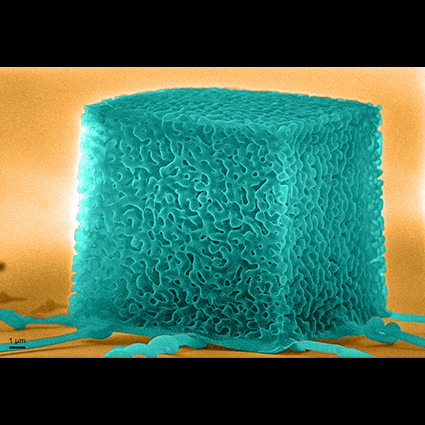
Three-Dimensional Nanoarchitected Hexagonal Boron Nitride (First-place winner)
Artist: James Surjadi
Description: Hexagonal boron nitride (hBN) is a critical nanomaterial for electronics, thermal management, and extreme conditions due to its high-temperature resistance, electrical insulation, piezoelectric properties, and high mechanical strength. However, most studies have focused on its two-dimensional (2D) form, with challenges in scaling it to three dimensions (3D) due to brittleness and microstructural changes. To overcome this, we created a 3D hollow hBN architecture (this image) with nanometer-thin shells using a 3D printed carbon scaffold and chemical vapor deposition, followed by scaffold removal. This architecture is 100 times lighter than water and fully recovers from 90% compression. This method can be scaled to 3D centimeter-sized samples while preserving the nanoscale features critical for maintaining hBN’s unique properties for applications such as ultrasensitive piezoelectric sensors for space explorations, microelectronics insulation, and lightweight, impact-resistant coatings.
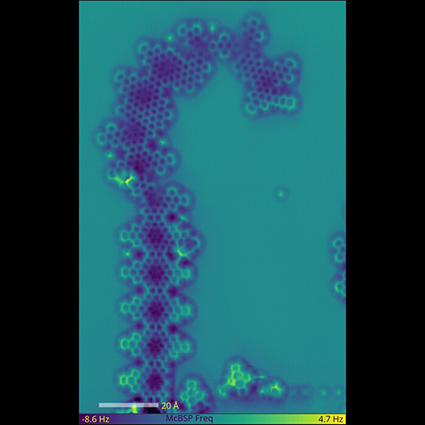
“The Seahorse”
Artist: Percy Zahl
Description: This is a high-resolution non-contact atomic force microscope (HR-AFM) image of a synthesized carbon (graphene) nano-ribbon structure on a gold surface. This technique can image bonding within molecular structures. Such materials are potential candidates of future electronics and have potential for novel optical or even quantum computing devices. About the imaging technique, invented in 2008 @ IBM Zurich: HR-AFM measures forces between the molecule’s »bonding« electrons and an inert CO molecule probe attached to the force sensor. Images represent the force seen about 3 Å above the molecule plane. A probe oscillation around 40 pm allows it to probe short range forces within the Pauli repulsion regime. A positive frequency shift indicates a repulsive force. Images were acquired at the Center for Functional Nanomaterials (CFN), which is a U.S. Department of Energy Office of Science User Facility, at Brookhaven National Laboratory.
If you have questions, please contact: nanoinfocus@nnco.nano.gov.




